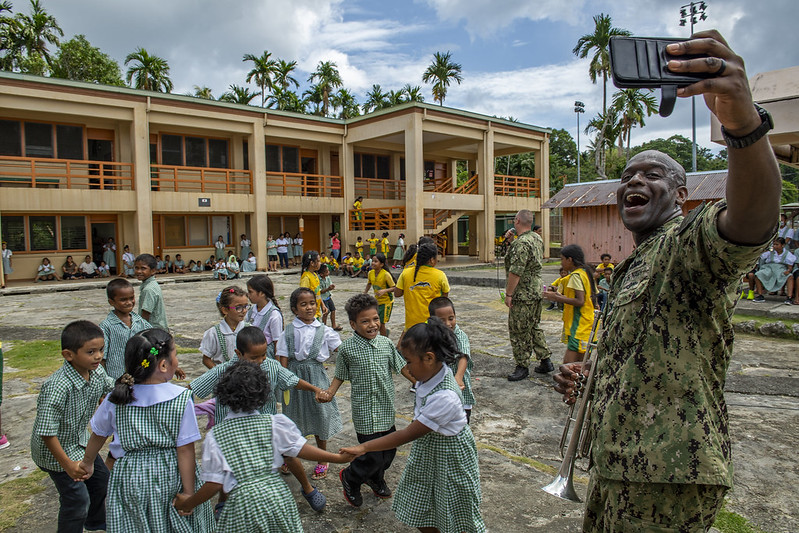Everything You Need To Know about Child Poverty in Palau
 Palau, an archipelago, emerges as a tiny island nation spanning a mere 458 square kilometers in the vast expanse of Oceania. The country’s population, estimated at approximately 21,779 in 2023, harbors a notable proportion of vulnerable young individuals, with around 21.6% below 18. While Palau boasts commendable achievements in health care, evidenced by its low child mortality rates compared to other Pacific Islands Countries and Territories (PICTs) groups, with the “Under 5 Mortality” rate (Per 1,000) being 13.3%, it still confronts issues of poverty that afflict its youngest inhabitants.
Palau, an archipelago, emerges as a tiny island nation spanning a mere 458 square kilometers in the vast expanse of Oceania. The country’s population, estimated at approximately 21,779 in 2023, harbors a notable proportion of vulnerable young individuals, with around 21.6% below 18. While Palau boasts commendable achievements in health care, evidenced by its low child mortality rates compared to other Pacific Islands Countries and Territories (PICTs) groups, with the “Under 5 Mortality” rate (Per 1,000) being 13.3%, it still confronts issues of poverty that afflict its youngest inhabitants.
Palau’s Economic Landscape
Palau’s economic landscape predominantly revolves around tourism, supported by agriculture and fishing. Palau is an upper-middle-income country with a Gross Domestic Product (GDP) per capita of US$13,230 in 2023. However, extreme poverty persists, particularly in rural regions with limited access to resources. The causes of family and subsequent child poverty in Palau are multifaceted and volatile. Palau also faces challenges similar to those of other PICTs. Theses include limited access to global markets, fragile resource bases, limited economies of scale, vulnerability to global economic changes and natural disasters that cause economic shocks.
The Extent of Child Poverty in Palau
The United Nations (U.N.) finds approximately 30% of children aged less than 14 living below the basic needs poverty line as of 2006. This is a huge indicator of child poverty in Palau. Children who grow up in poverty lack the necessities of life, such as food, cleanliness, shelter, health care and education. Globally, around one billion children are “multidimensionally” impoverished, which means they lack basic requirements such as nutritious food and safe water.
There is an absence of comprehensive data on childhood wasting and stunting, which is hindering efforts to address malnutrition and its adverse effects on child development. Equally concerning is the prevalence of obesity among Palauan youth, with a staggering 35% of them being classified as overweight or obese. These statistics prove that there is an urgent need for action to address not only material deprivation but also nutritional provision in food and underlying health disparities among Palau’s children.
Efforts to Combat Child Poverty in Palau
In response to these challenges, in collaboration with governmental and nongovernmental entities, the National Youth Council (NYC) of Palau plays an imperative role in advocating for youth empowerment and social inclusion. In the long run, this can be seen as a benefit to upskilling the youth. It provides them with better employment opportunities and, hence, leaves them less vulnerable.
NYC Palau, established in 2004, is dedicated to empowering youth by collaborating with government and NGOs to offer various services and activities. Through extensive research and database management, it monitors youth engagement in various sectors, assesses their well-being and addresses issues such as substance abuse, unemployment and conflicts with the law. Using this data, NYC Palau formulates policy mandates to achieve youth empowerment goals, setting targets for partner organizations.
President Tommy Remengesau also declared 2016 the “Year of the Youth” to prioritize youth welfare and enable an environment for their development. The declaration aims to implement a comprehensive youth strategy through the council that promotes all organizations to better identify and serve the interests of Palau’s youth. Additionally, NYC Palau implements career counseling programs, school-specific initiatives and schemes to enhance Palau’s labor market, which are often supported by grants.
Palau’s Commitment to Child Rights
Palau’s commitment to combating child labor, a grave reality and consequence of child poverty, is also displayed by its ratification of Convention No. 182 by the International Labour Organization (ILO). The 182nd Convention of ILO addresses the prohibition and elimination of the worst forms of child labor. This includi slavery, sexual exploitation, the involvement of children in armed conflict, prostitution, pornography and drug trafficking that endanger children’s health, morality or psychological well-being.
In 2019, Palau took significant steps to protect children from the worst forms of child labor by enacting a new Penal Code. This legislation specifically targets child pornography and the trafficking of children for labor exploitation, underscoring Palau’s commitment to safeguarding children’s rights and welfare. This is in addition to its impressive Realization of Children’s Rights Index score of 8.17 out of 10.
Final Remark
Child poverty in Palau is a multifaceted issue that demands nuanced solutions and collaborative efforts across sectors. Palau can chart a path toward sustainable development and social justice by continuing to address the underlying determinants of poverty, investing in education and health care and prioritizing youth empowerment.
– Malaikah Niyazi
Photo: Flickr
